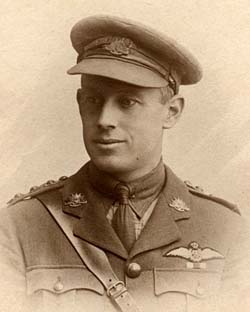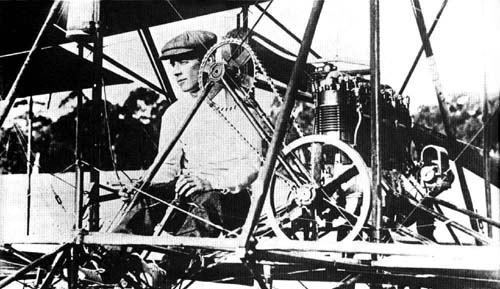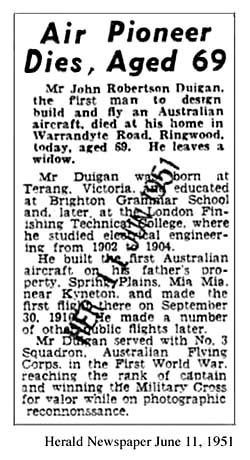
|

John Robertson Duigan |
| also on this site, a vast gallery of pages from contemporary local and overseas aviation journals and newspapers and most notably, photographs taken at Spring Plains during the earliest flights, many not previously published. A number of the photographs were annotated by the brothers thus tying some images (and Australian aeronautical history) right down to a specific day.....enjoy! |
John Robertson Duigan
Born on May 31, 1882 at Terang, Victoria, John Robertson Duigan studied electrical and motor engineering at Finsbury College in London. He returned to live at Spring Plains, where he, in 1908 with his younger brother Reginald (b:1889), commenced experiments in aviation
After the first successful aeroplane of 1909/10 (and a lesser known second machine constructed in 1912 with AV Roe in England), John now back in Australia and again with the help of his brother Reginald, constructed a third aircraft at their parents' home in Ivanhoe, a suburb of Melbourne, Victoria
The aircraft, a two seat tractor biplane based on the AVRO ENV crashed on its maiden flight at Keilor Plains in February 1913. In the crash John was badly bruised and the brothers did not rebuild the aircraft.
John Duigan was awarded the Military Cross for gallantry in action during WW1. He later opened his own motor engineering business in Yarrawonga. He served in the Quality Control Branch of the Royal Australian Air Force in WW2. Duigan retired to Melbourne, where he died in 1951. A memorial to the first flight was unveiled in 1960, about six kilometres from Mia Mia on the Mia Mia-Lancefield Rd.
Designing and Building the Duigan Aircraft
Duigan based his aircraft design on the French 'Farman' [bi]plane, which had flown a kilometre in 1908. Duigan prepared his own plans and specifications and in a large shed on the family prperty, constructed the frame of the plane from red pine and mountain ash
Duigan also made the wheels, propeller shaft, and the ball bearing races. He later cast his own water-pump and made his own radiator. The J.E. Tilley Engineering Company of Melbourne supplied a twenty horsepower, four cylinder engine, and Mr. J. Fulton of Melbourne made the two metre by 15 centimetre propeller.
To fly the aircraft, it had to be moved from its shed, down a steep hill and across two creeks, over which special bridges were built. The dimensions of the take-off field were 1183 metres x 91 metres, which allowed for relatively straight flights only, and limited them to less than 800 metres. Three persons were required to move the aircraft back up the hill to the shed.

John Duigan at the controls of his Pusher Biplane, 1910
National Library of Australia
Download a 1000 pixel version of this image
The First Long Flight
After a successful flying 'hop' on July 16, 1910, Duigan applied to the Defence Department for details of the Commonwealth Prize of 5000 Pounds then being offered to the builder of a suitable military aircraft. He made further improvements to the plane by rebuilding the engine for increased power and providing greater balance to the wing design.
On October 7, 1910, Duigan made his first sustained flight of 178 metres at a height of about three metres, before half a dozen spectators. Duigan described this achievement as his first successful flight under full control. Duigan's application for the Commonwealth prize was rejected because he missed the close of entries in March 1910. However, the Defence Department requested a demonstration of the machine in May 1911.
Along with his brother Reginald, John Duigan continued to fly the aircraft locally, reaching distances of two kilometres and altitudes of between two and 18 metres. The plane completed sixty flights before being placed in a hangar where it remained through the years of World War I. In 1920, Duigan donated the aircraft to the Industrial and Technological Museum of Victoria, which later became part of Museum Victoria.
The Duigan Replica
In January 2000, Museum Victoria received the donation of a complete Duigan Replica, built by flight mechanic Ronald Lloyd Lewis (1919-1995). Mr Lewis handcrafted the plane between 1984 and 1990, using his own specially-made tools. From July 1, 2000 the Duigan Replica has taken up pride of place in the Grande Galleria inside the entrance to the new Melbourne Museum, a campus of Museum Victoria and located in the Carlton Gardens just north of the Melbourne CBD.
Duigan Aircraft Specifications
Overall Wing Span: 10.5 m
Engine: Tilley 4-cylinder air, water cooled, 18.6 kW (25 hp) at 1800 rpm
Fuel tank capacity: 4.55 L
Max speed: 64 km/h. Take off run approximately 91m in 6 km/h wind.
Further Reading
Brodgen, Stanley, (int.Reginald Charles Duigan), John Duigan's Plane Made History, Aircraft, Australia's Aviation Magazine, The Herald and Weekly Times, Melbourne, October, 1960
Kendall, F. J., John Robertson Duigan : A Pioneer Aviator in Australia, (An Address to the Society on Tuesday evening 26 February, 1974), The Victorian Historical Magazine. Journal and Proceedings of the Royal Historical Society of Victoria, 177th Issue, Vol. 45, Number 3, August 1974, pp.141-58.
Meggs, Keith, John Duigan, The History of the Australian Aircraft Industry, Chap. 3 (excerpt), as pre-published in Aviation Heritage, Vol. 26 No.1, 1990
Mc Laren, Ian, Australian Aviation : A Survey, (An Address to the Society on 18 September, 1957), The Victorian Historical Magazine. Journal and Proceedings of the Royal Historical Society of Victoria, 111th Issue, Vol. XXVIII, Number 3, August 1958, chapters 2 and 3, pp.88-91
Parnell, L., & Boughton, T., Flypast: A Record of Aviation in Australia, AGPS Press, Canberra, 1988
Adapted (with corrections) by Dr Russell Naughton from Technology Program - Infozone Fact Sheet Draft © Museum Victoria
First flight in an Australian designed aircraft, 1910
In 1909 and 1910 there was a desperate race to be the first person in Australia to fly in a powered aircraft. The first few flights were made in aeroplanes that had been brought in from overseas, and which only stayed in the air for a few minutes.
On July 16, 1910, at Mia Mia in Victoria, pioneer aviator John Duigan was the first person to fly an Australian designed and built powered aircraft. He flew seven metres in his tiny aeroplane, and was in the air for just a few seconds. This brief flight that was over almost before it had begun took place only a few years after the Wright brothers flew at Kittyhawk, North Carolina..
John Duigan and his younger brother Reginald had spent nearly a year building his aircraft, which was made from wood, wire taken from an old piano, and steel bands usually used for baling wool. A 25-horsepower, 4-cylinder engine powered the frail aeroplane. After this first flight, John Duigan and his brother spent months making their aeroplane more stable and were soon able to fly about a kilometre in it.
This experience was useful for John Duigan when a few years later he flew in France during WW1. It was also important to be able to travel long distances safely and fast in such a large country as Australia, which is also so far away from countries such as Europe and America. Early pioneers such as John and Reginald Duigan helped to transform communication and travel for all Australians.
adapted from http://www.historysmiths.com.au

National Library, Canberra
Biographical cuttings are mentioned as available on John Robertson Duigan, aviator, Reginald C.(Charles) Duigan, inventor
© Copyright 1999 CTIE - All Rights Reserved - Caution |